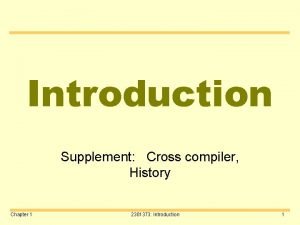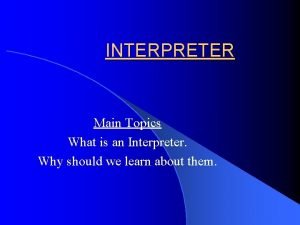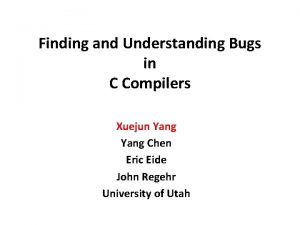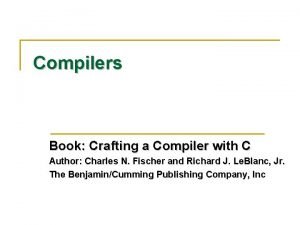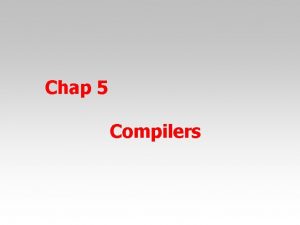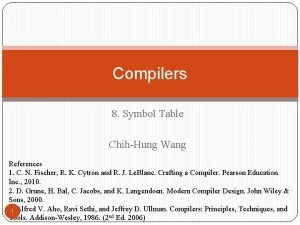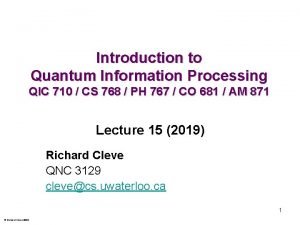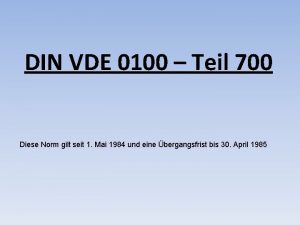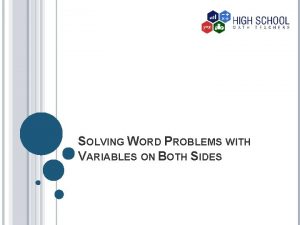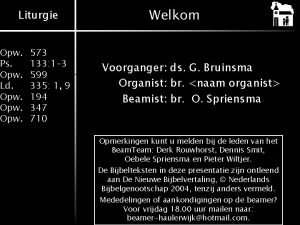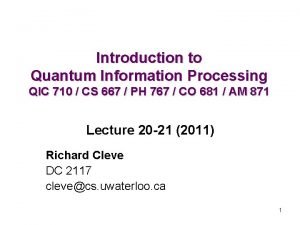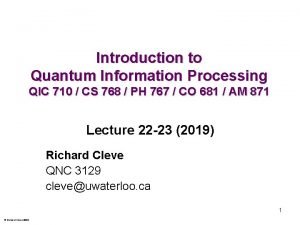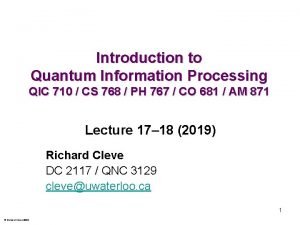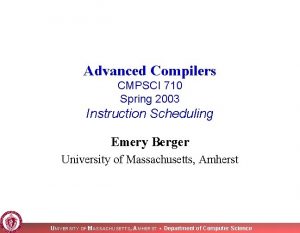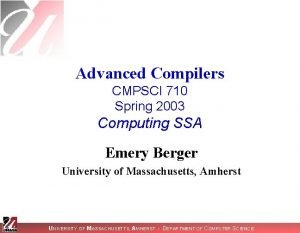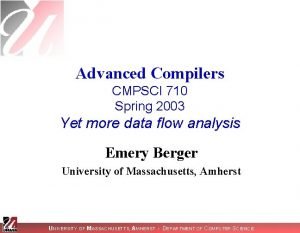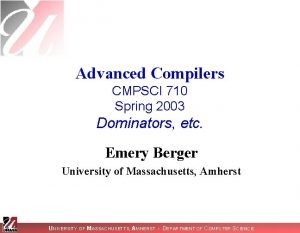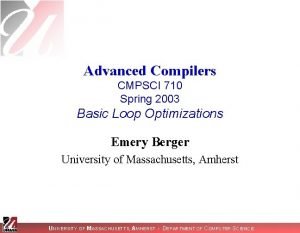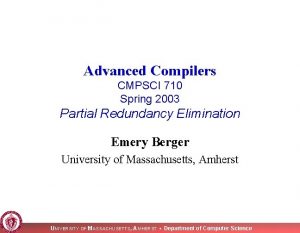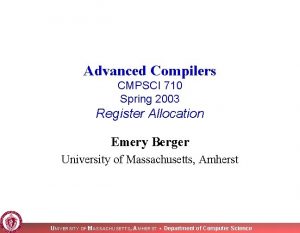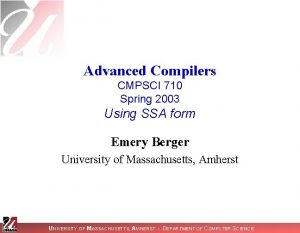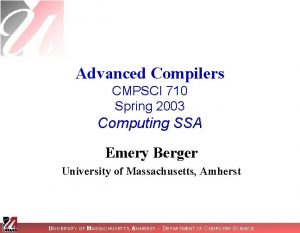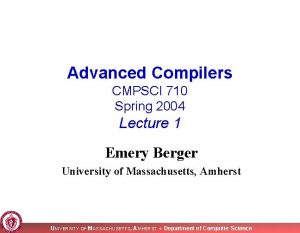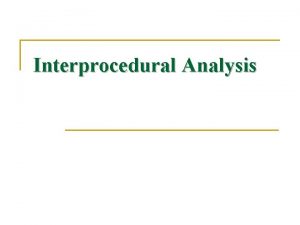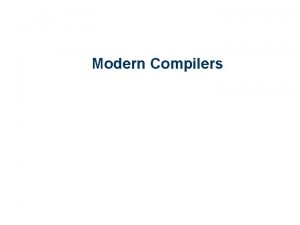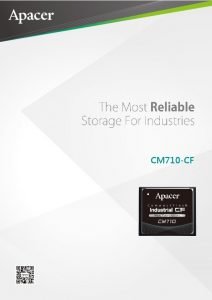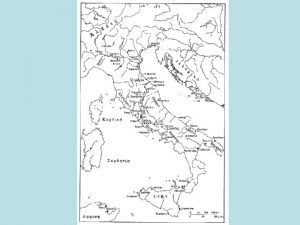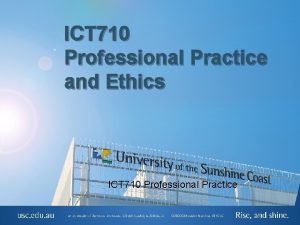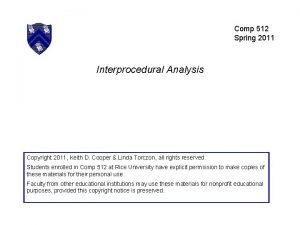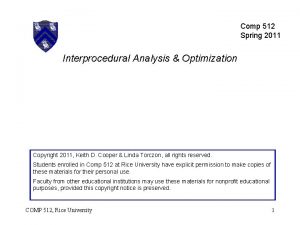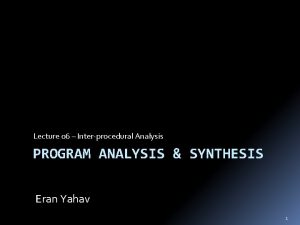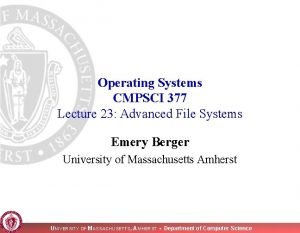Advanced Compilers CMPSCI 710 Spring 2003 Interprocedural Analysis























- Slides: 23

Advanced Compilers CMPSCI 710 Spring 2003 Interprocedural Analysis Emery Berger University of Massachusetts, Amherst UNIVERSITY OF MASSACHUSETTS, AMHERST • Department of Computer Science

Topics n n Up to now n Intraprocedural analyses n Dataflow analyses n Def. Use, SSA n Register Allocation n Scheduling n Just for individual procedures Today: Interprocedural analysis n across/between procedures n Why? UNIVERSITY OF MASSACHUSETTS, AMHERST • Department of Computer Science 2

Aliasing n Formals and/or globals may be aliased n n n Two names point to same location Only form of aliasing for Java, Fortran At procedure call n Globals may be modified or used n Actual args may be modified or used UNIVERSITY OF MASSACHUSETTS, AMHERST • Department of Computer Science 3

Aliasing Examples, I n Need alias analysis to do: n Instruction scheduling n Register allocation UNIVERSITY OF MASSACHUSETTS, AMHERST • Department of Computer Science 4

Aliasing Examples, II n Need alias analysis to do: n Dead code elimination n Code motion UNIVERSITY OF MASSACHUSETTS, AMHERST • Department of Computer Science 5

Alias Examples, III n n Need alias analysis to do: n Constant propagation To perform alias analysis, we need… UNIVERSITY OF MASSACHUSETTS, AMHERST • Department of Computer Science 6

Interprocedural Analysis n Goals n n Enable standard optimizations even with procedure calls Reduce call overhead for procedures Enable optimizations not possible for single procedures Optimizations Register allocation n Loop transformations n CSE, etc. UNIVERSITY OF MASSACHUSETTS, AMHERST • Department of Computer Science n 7

Problems with Interprocedural Analysis n Not without drawbacks n Whole-program analysis n n What about libraries? Separate compilation requires recompilation analysis [Burke & Torczon 93] Expensive Doesn’t scale well, or worse n Some problems intractable n e. g. , Flow-sensitive kill UNIVERSITY OF MASSACHUSETTS, AMHERST • Department of Computer Science 8

Analysis Sensitivity n n Flow-insensitive n What may happen (on at least one path) n Linear-time Flow-sensitive n Consider control flow (what must happen) n Iterative data-flow: possibly exponential Context-insensitive n Call treated the same regardless of caller n “Monovariant” analysis Context-sensitive n Reanalyze callee for each caller n “Polyvariant” analysis n More sensitivity ) more accuracy, but more expense UNIVERSITY OF MASSACHUSETTS, AMHERST • Department of Computer Science 9

Context Sensitivity n n n Reanalyze callee as if procedure was inlined Too expensive in space & time n Recursion? Approximate context sensitivity: n Reanalyze callee for k levels of calling context UNIVERSITY OF MASSACHUSETTS, AMHERST • Department of Computer Science 10

Summary Information n Another approach: summarize each procedure n Effect/result of called procedure for callers n Effect/input of callers for called procedure n Store in database for use by later optimization pass Pros: + Concise + Fast + Practical: separate compilation Cons: - Imprecise UNIVERSITY OF MASSACHUSETTS, AMHERST • Department of Computer Science 11

Two Types of Information n Track info that flows into procedures n “Propagation problems”, e. g. : n n n which formals are constant? which formals are aliased to globals? Track info that flows out of procedures n “Side effect problems”, e. g. : n n n which globals defined/used by procedure? which locals defined/used by procedure? Which actual parameters defined by procedure? UNIVERSITY OF MASSACHUSETTS, AMHERST • Department of Computer Science 12

Propagation Summaries: Examples n MAY-ALIAS n n MUST-ALIAS n n Formals that may be aliased to globals Formals definitely aliased to globals CONSTANT n Formals that are definitely constant UNIVERSITY OF MASSACHUSETTS, AMHERST • Department of Computer Science 13

Side-Effect Summaries: Examples n MOD n n REF n n Variables possibly modified (defined) by procedure call Variables possibly referenced (used) by procedure KILL n Variables that are definitely killed in procedure UNIVERSITY OF MASSACHUSETTS, AMHERST • Department of Computer Science 14

Computing Summaries n Bottom-up (MOD, REF, KILL) n n Top-down (MAY-ALIAS) n n Summarizes effect of call Summarizes information about caller Bi-directional (AVAIL, CONSTANT) n Info to/from caller & callee UNIVERSITY OF MASSACHUSETTS, AMHERST • Department of Computer Science 15

Implementing IPA: The Call Graph n Represent procedure call relationship by call graph n n n G = (V, E, start) Each procedure is unique vertex Call site = edge between caller & callee n n n (u, v) = call from u to v Can label with source line Cycles represent recursion UNIVERSITY OF MASSACHUSETTS, AMHERST • Department of Computer Science 16

Call Graph Example UNIVERSITY OF MASSACHUSETTS, AMHERST • Department of Computer Science 17

Side-Effect Summarization n At procedure boundaries: n n Translate formal args to actuals at call site Compute: n n GMOD, GREF = procedure side effects MOD, REF = effects at call site n Possibly specific to call UNIVERSITY OF MASSACHUSETTS, AMHERST • Department of Computer Science 18

Side-Effect Summary Example UNIVERSITY OF MASSACHUSETTS, AMHERST • Department of Computer Science 19

Alternatives to IPA: Inlining n Inlining: replace call with procedure body n Pros + Exposes context & side effects + Simple n Cons - Code bloat (bad for caches, branch predictor) Can’t decide statically for OOPs Library source? Recursion? How do we decide when to inline? UNIVERSITY OF MASSACHUSETTS, AMHERST • Department of Computer Science 20

Alternatives to IPA: Cloning n n n Cloning: customize procedure for certain call sites Partition call sites to procedure p into equivalence classes n e. g. , {{call 3, call 1}, {call 4}} Equivalence based on optimization n Constant propagation: partition based on parameter value UNIVERSITY OF MASSACHUSETTS, AMHERST • Department of Computer Science 21

Cloning n Pros + + n Compromise between inlining & IPA Less code bloat compared to inlining No problem with recursion Improves optimization potential (compared to IPA) Cons - Some code bloat (compared to IPA) - Doesn’t eliminate need for IPA - How do we partition call sites? UNIVERSITY OF MASSACHUSETTS, AMHERST • Department of Computer Science 22

Conclusion n Interprocedural analysis n Difficult but expensive n n n Useful for many optimizations IPA and cloning likely to become more important n n Need source code, recompilation analysis Trade-offs for precision & speed/space Better than inlining Java: many small procedures Next time: n Homework 2 review UNIVERSITY OF MASSACHUSETTS, AMHERST • Department of Computer Science 23
 Bae yong-kyun
Bae yong-kyun Elsa gunter uiuc
Elsa gunter uiuc Compilers binarymove
Compilers binarymove Cross compilers
Cross compilers What is an interpreter
What is an interpreter Finding and understanding bugs in c compilers
Finding and understanding bugs in c compilers Compilers book
Compilers book Functions of compiler
Functions of compiler Front end phases of compiler
Front end phases of compiler Symbol table implementation in lex and yacc
Symbol table implementation in lex and yacc If an error occurs, what interpreter do?
If an error occurs, what interpreter do? Cs 421 programming languages and compilers
Cs 421 programming languages and compilers Fall months
Fall months Da form 2062
Da form 2062 Qic 710
Qic 710 Vde 0100 gruppe 700
Vde 0100 gruppe 700 454 hangi yüzlüğe yuvarlanır
454 hangi yüzlüğe yuvarlanır Ortec 710
Ortec 710 A gas has a pressure of 710 kpa at 227
A gas has a pressure of 710 kpa at 227 Word problem equations with variables on both sides
Word problem equations with variables on both sides Opw 710
Opw 710 Qic 710
Qic 710 Qic 710
Qic 710 Qic 710
Qic 710



